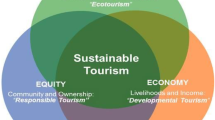Abstract
In China, community tourism is still a relatively new phenomenon, but the villagers of a small Qiang village in the Qiang Autonomous County of Beichuan in Southwestern Sichuan have initiated tourism in a way which conforms to the basic theory of community tourism development. This demonstrates that community tourism possesses a strength and vitality that can promote the development of tourism in the rural and mountainous areas. In the district of Zhenghe Village, the tourism industry, based on the community tourism model, is the mainstay of its economy. The practice of community tourism in the village not only promotes the economic development of the village community, but also leads to the protection of the mountainous natural environment and of the culture of the Qiang people. This paper investigates the development process of community tourism in Zhenghe and shows how the local residents participate in this process. It also looks at how profits have been distributed within the community. It demonstrates that community tourism is a correct choice by the Zhenghe people as they have clearly been moving from poverty to prosperity, while the local ecology and environment have been simultaneously protected. The authors hope that other minority villages with similar local conditions and natural resources will be able to use this example to develop their own community tourism.
Similar content being viewed by others
References
Bracht, Neil and Agis Tsouros. 1990. Principles and Strategies of Effective Community Participation. Health Promotion International 5(3): 199–208.
Brougham, J. E. and B. W. Butler. 1981. A Segmentation Analysis of Resident Attitudes to Social Impact of Tourism. Annals of Tourism Research (4): 569–590.
Campbell, Lisa M. 1999. Ecotourism in Rural Developing Communities. Annals of Tourism Research 26(3): 534–553.
CHENG Yi, ZHANG Yifeng. 2007. Progress in Foreign Research on Community Tourism. Yunnan Geographic Environment Research 19(1):135–141. (In Chinese).
CHENG Zhu. 2006. Community Participation Mode of Ecotourism in Tibetan Area of Shangri-La County, Yunnan Province. Ecological Economy 2(3): 306–318.
GENG Jing. 2006. A Comprehensive Review of Study of the Qiang, Guizhou Ethnic Studies 24(3): 173–177. (In Chinese).
GUI Yanli, FANG Yangang, LIU Jisheng. 2004. Community-Based Ecotourism In Nature Reserve of China. Chinese Geographical Science 14(3): 276–282.
Hall, Derek and Greg Richards. 2000. Tourism and Sustainable Community Development. Routledge. Pp. 1, Pp.11
Hampton, Mark P. 2005. Heritage, Local Communities and Economic Development. Annals of Tourism Research 32(3): 735–759.
HUANG Hua, WANG Jie, HUANG Rong. 2007. Preliminary Research into the Development of Participatory Community Tourism in Ethnic Minority Villages. Market Modernization April 2007: 219–220. (In Chinese).
Kruger, Linda E. 2005. Community and Landscape Change in Southeast Alaska. Landscape and Urban Planning 72: 235–249.
Lankford S. V. and D. R. Howard. 1994. Developing a Tourism Impact Attitude Scale. Annals of Tourism Research 21(1):121–139.
LIANG Yuhua, CHENG Zhiyong, LI Lejing. 2006. Studying on Villagers of Minority Village Participation in the Tourism Development — Taking Zhenshanchun as an Example. Guizhou Ethnic Studies, Vol.26 No.6: 39–45. (In Chinese).
LI Jie, ZHAO Xiping. 2001. On Some Theoretical Problems Concerning the Community Participation and Tourism Development. Tourism Tribune, Vol. 16(4): 44–47. (In Chinese).
LU Jun. 2006. Wulong’s Inner Chamber. Nationalities Forum. July 2006: 42–4 (In Chinese).
LU Xingfu, LU Lin. 2007. A Study on the Stagewise Characteristics of Travel in Minority Communities — Taking Several Villages and Towns in Yunnan as an Example. Tourism Tribune 22(2): 38–42. (In Chinese).
Murphy, P. E. 1980. Tourism Management in Host Communities. Canadian Geographer 24: 1–4.
Pratiwi, Sudhiani. 2000. Understanding Local Community Participation in Ecotourism Development: A Critical Analysis of Select Published Literature. Unpublished MS thesis. Michigan State University
Roddick, A. 2000. Business as Unusual. London: Thorsons. P55.
Ross, G. F. 1992. Resident Perceptions of the Impact of Tourism on an Australian City. Journal of Travel Research 30(3): 13–17.
Stone, L. 1989. Cultural Crossroads of Community Participation in Development: a Case from Nepal. Human Organization 48(3): 206–213.
Stronza, Amanda L. 2000. ’Because it is ours’: Community-based ecotourism in the Peruvian Amazon. Ph.D. thesis. University of Florida.
WU Zhongjun, YE Ye. 2005. The discuss about Ethical community tourism benefit distribution and validity of resident’s participation — Take Guilin Longsheng Longji Terrace Scenic Spot Pingan Village as Example. The Journal of Guangxi Economic Management Cadre College 17(3): 51–55 (In Chinese).
Author information
Authors and Affiliations
Corresponding author
Rights and permissions
About this article
Cite this article
Zhou, L., Liu, K. Community tourism as practiced in the mountainous Qiang region of Sichuan Province, China — a case study in Zhenghe Village. J. Mt. Sci. 5, 140–156 (2008). https://doi.org/10.1007/s11629-008-0098-8
Received:
Accepted:
Published:
Issue Date:
DOI: https://doi.org/10.1007/s11629-008-0098-8




